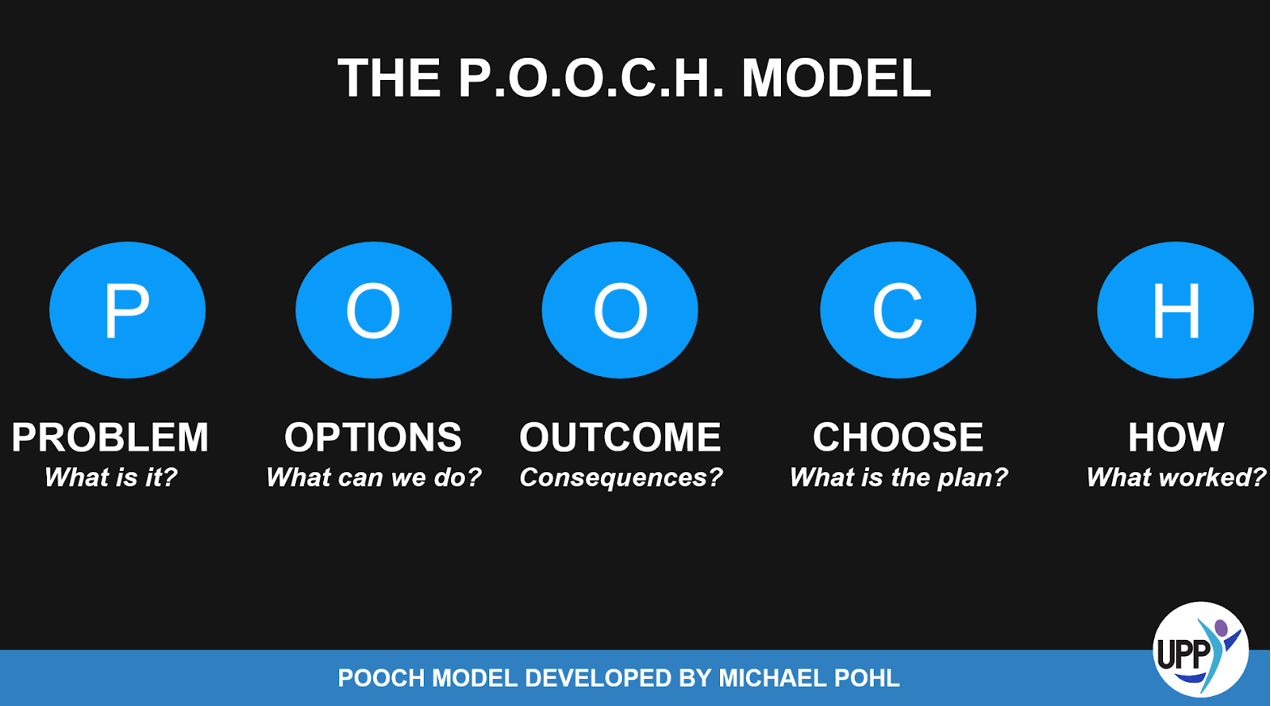LESSON 4:
Problem Solving Using POOCH
This lesson supports peer mentors by helping them to understand what effective teams look like and develops their problem solving and decision making skills through the use of the POOCH model. The lesson equips peer mentors, through practical steps, with the skills needed to help their peers navigate challenges and build stronger, more supportive relationships.
Equipment:
UPP Workbook and Pen
Notebook
Coloured Pencils
Lesson Objectives:
By the end of this lesson, students will be able to:
Understand the POOCH problem-solving method (Problem, Options, Outcomes, Choose, How did it go?).
Practise applying the POOCH method to a variety of real-world scenarios.
Develop critical thinking and decision-making skills to manage challenges they may face as a peer mentor effectively.
ACTIVITY 1 - Riddle
TIME: 5 Minutes
Method:
Time: 5 minutes
Get students into pairs or small groups. Display the following riddle where all students can read it (up on the white/black/smart board).
You have a fox, a chicken and a sack of grain. you must cross a waterfall with only one of them at a time. If you leave the fox with the chicken it will eat the chicken; if you leave the chicken with the grain it will eat the grain.
Instructions:
Ask students to read this problem silently.
Once everyone has finished reading the problem, ask students to get into groups of five.
Tell students that you are setting a timer for five minutes (classroom teacher can adjust time, depending on the nature of the students and size of the group) and that when you start the timer students have five minutes to try and solve the mystery in their table group.
Once the five minutes is up, get the groups to share the answers they came up with and see if any groups got it correct!
Answer:
Take the chicken first and drop him on the other side of the waterfall.
Go back and bring the grain to the other side of the waterfall, don’t leave the chicken with the grain, bring the chicken back with you to the fox.
Leave the chicken this time and take the fox over to the grain.
Finally go back and get the chicken.
Activity Debrief:
This activity encourages students to work together, explore different options and consequences, whilst really concentrating to solve the problem. Students realise that the first way of trying to solve a problem may not always be the best option. Peer mentors may have to consider different options and their individual outcomes to solve a problem effectively, both in this activity and at school. This activity supports student resilience and perseverance as by not giving up, they are able to come up with the solution to the riddle.
ACTIVITY 2 - video and Discussion:
TIME: 10 minutes
After watching the video, recap each step of the POOCH model if needed.
Problem: Define the issue clearly.
Options: List possible solutions to the problem.
Outcomes: Predict the likely results of each option.
Choose: Weigh up the different outcomes and select the best/most appropriate option.
How did it go? Reflect on whether it worked and what could be improved.
Discuss with students which steps of the POOCH model they may find easier, and more difficult, to complete and why. Remind students that depending on the nature of the problem they are facing, they may have more than one suitable option. This may be challenging for them and encourage students to seek support from other peer mentors and an appropriate teacher or staff member if necessary.
activity 3 - Problem Solving using the POOCH model
TIME: 20+ Minutes
Next, divide students into small groups. The students will be given the following scenario:
Someone you are mentoring has come to you with the following problem:
“I have been paired with a student I do not get along with by my teacher for a class project.”
The groups will work together to complete the POOCH model on page 11 of their workbook to help resolve the problem for the student.
Once all groups have completed all sections of their POOCH model, discuss answers as a class.
Then, provide the students with a different scenario that is relevant to them and their school context, and ask students to complete the second POOCH model on page 12 of their workbooks.
Once all groups have completed their POOCH model for their school scenario, discuss as a class what each group wrote for each step. At the final step, Choose, challenge the peer mentors to decide as a team which option from all of the answers discussed, is going to be the best one.
conclusion
TIME: 10 minutes
Reflection
Ask students to think of a personal challenge they’re facing and write down how they could use POOCH to address it.
Share examples anonymously if comfortable.
Emphasise that the POOCH method is a practical tool they can use in school as a peer mentor, and support can be sought from other peer mentors and/or appropriate teaching staff if students are unsure of which option to choose.
These resources have been curated and built for you by Unleashing Personal Potential.

